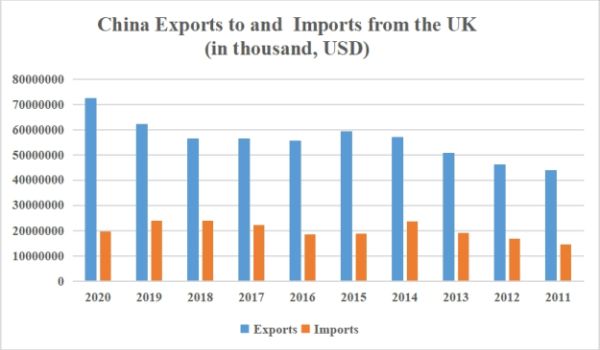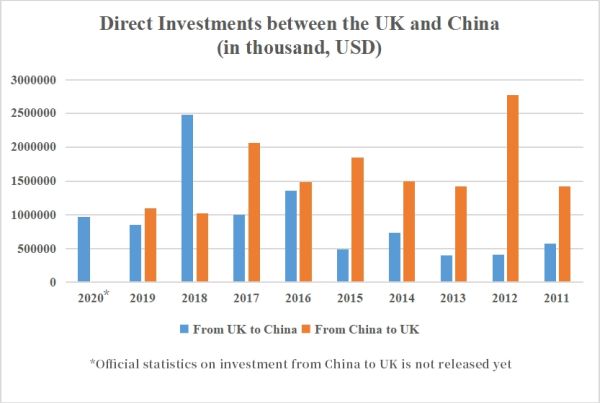Introduction
In the spring of 2011, I went to the UK to assist a Chinese client in negotiating and completing the acquisition of a European group of companies headquartered in the UK. At that time, the Chinese "Belt and Road" Initiative had not been proposed and the momentum for the Chinese companies to invest in the UK and other countries was just being built. That summer, I went to the UK again to discuss an antidumping case with the UK representatives at the EC anti-dumping committee. At that time, the trade volume and value between the EU (including the UK) and China were rapidly growing. By the summer of 2015, the then Prime Minister David Cameron was heralding a "Golden Era" for the trade and investment relationship between the UK and China.
How dramatically things have changed in a decade. The UK has exited the EU and fallen into diplomatic disputes with China, with the trade and investment flows between the two countries becoming unpredictable...
Surge of Trade and Investment Activities between the UK and China
Let's check some statistics first:

Source: National Bureau of Statistics of China, and General Administration of Customs (Data for 2020), China

Source: National Bureau of Statistics of China.
By the above statistics, the total value of trade between the UK and China reached USD92,368,670,000 in 2020, with lots of room for the UK to increase its exports to China; and the total value of investment between the UK and China peaked at USD3,508,280,000 in 2018, despite a drastic drop in 2019.
Need for a UK-China Free Trade Agreement
As such, and as the UK was exiting the EU, a free trade agreement ("FTA") between the UK and China has since been proposed. An FTA could deal with market access, tariff concessions, trade in goods, trade in services, subsidies, investments, intellectual property protection and all other trade and investment related topics and would greatly increase the trade and investment flows between the contracting parties.
Up to date, there has been only a bilateral investment treaty ("BIT") which was signed between the UK and China back in 1986, and which now appears insufficient for the substantially increased trade and investment activities between the UK and China.
In contrast, the EU and China was able to reach in principle a Comprehensive Agreement on Investment ("CAI") at the end of 2020. The CAI is indeed very comprehensive in that it contains not only the investment protection provisions that are typically included in today's BITs, but also market access, sustainable development and other provisions that are normally seen in the FTAs. The CAI, if finalized and approved by both the EU and China, would provide a solid legal basis for the increase of the trade and investment flows between the EU and China.
A UK-China CAI?
As discussed above, for the protection and facilitation of the surge of the trade and investment activities between the UK and China, there is only one 1986 UK-China BIT in place.
The 1986 UK-China BIT is outdated in many ways and needs to be modernized. A modernized BIT such as the EU-China CAI would contain detailed provisions on national treatment (NT), most-favored nation treatment ("MFN"), fair and equitable treatment, full protection and security, freedom of transfer of funds, prohibition against unreasonable, arbitrary or discriminatory measures, prohibition of performance requirements, reasonable compensation for expropriation, facilitation of personnel entry and sojourn, transparency of laws and regulations, investor-state dispute settlement (ISDS) and other progressive provisions.
The 1986 UK-China BIT, although it does contain some of those provisions, fails to set them out in a modernized way. For one example, the UK-China BIT requires only post-establishment NT and MFN while today's BITs require pre-establishment NT and MFN. It is actually very important to extend NT and MFN to the foreign investor before it sets up its investment in the hosting country. For another example, the 1986 UK-China BIT is silent on and therefore does not require transparency of laws and regulations. But transparency has since become a hallmark requirement in today's FTAs and BITs. Further for an example, the 1986 UK-China BIT limits ISDS to the issue of the amount of compensation (for expropriation), while in today's BITs, allowing ISDS for all relevant issues has become a standard requirement.
It is assumed that increased trade and investment activities necessitate increased treaty protection and facilitation. FTAs and BITs are usually such treaties to negotiate and conclude. However, an FTA, such as the RCEP, CPTPP and EU-Canada CETA, could take quite some years to negotiate and approve. A BIT, on the other hand, could be negotiated and approved faster. Especially, with 1986 UK-China BIT in force and the EU-China CAI as a model, UK and China could negotiate and approve a UK-China CAI relatively quick. Given the difficult approval procedures at the EU, it is not impossible for such UK-China CAI to be concluded and approved before the EU-China CAI.
The only prerequisite is, of course, the political will and determination on both sides.
Epilogue
It is worth to note that, while the European Parliament voted to suspend their ratification process for the EU-China CAI on 20 May 2021 for the political disputes between the EU and China, both the UK and China have formally applied to join the CPTPP (the Comprehensive and Progressive Agreement for Trans-Pacific Partnership). The UK did so on 1 February 2021, and China did so on 16 September 2021. CPTPP currently has 11 members, which are Australia, Brunei Darussalam, Canada, Chile, Japan, Malaysia, Mexico, New Zealand, Peru, Singapore and Vietnam, and boasts the most comprehensive and progressive contents for a free trade agreement. Are such requests for accession a demonstration that the UK and China have a shared perspectives on what should be included in a free trade agreement?
The content of this article is intended to provide a general guide to the subject matter. Specialist advice should be sought about your specific circumstances.

